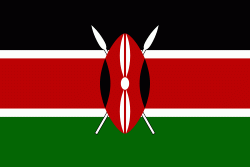Chuka (Chuka)
Chuka is a town on the eastern slopes of Mount Kenya, in Kenya about 65 km south Of Meru Town. It falls within Tharaka-Nithi County and the former Eastern Province. Between 1992 and 2009, Chuka was the capital of Tharaka Nithi District (split off from Meru District). Tharaka Nithi District was further split into Meru South and Tharaka Districts with Chuka remaining the Capital of Meru South. Later, Meru South and Tharaka were amalgamated into Tharaka-Nithi County.
The people of the area are Gichuka speaking, a dialect of the Kimeru language.
Chuka Town is chiefly occupied by the Chuka people, one of the nine Meru dialect Speakers. They dwell on the south-eastern slopes of Mt. Kenya, and cover the area between the Thuci River in the south, and the Nithi River in the north. It is a common tradition with the Chuka that they have always been in the forests of Mt. Kenya hence they moved down to their present abode. Other versions of the Chuka migratory tradition say that they came out from Mbwa with the other Meru.
The Chuka are believed to have sprung from the Tharaka, another of the meru subtribes. They have also a form of blood-brotherhood with the Igembe and the Tigania of the northern meru dialects. On the other hand, there are some customs, as, for instance, the method of circumcision, by which the Chuka are similar to the Embu. The Chuka are primarily Meru who, having climbed the first slopes of Mt. Kenya, clearing the forest for cultivation (even at present the fields of the Chuka are on the lower section of their country), mixed with the aboriginal inhabitants of the forest and established some kind of contact with the Embu. These aboriginal forest inhabitants seem to have been the Gumba, now only remembered by some traditions and described as very small people. It seems certain that they were a pygmy race.
Some even say that the Chuka may have come from the Coast about AD 1300. Their exodus was provoked by an invasion from Somalia, which drove away the people living round Shungwaya, north of Malindi.
Of the former Meru District, the Chuka were those who have suffered most the impact and violence of Mau Mau rebellion. During the Emergency, they were the only Meru to be forcibly settled into villages of the Kikuyu and Embu pattern. Later, they were allowed to return to their fields, as before.
The people of the area are Gichuka speaking, a dialect of the Kimeru language.
Chuka Town is chiefly occupied by the Chuka people, one of the nine Meru dialect Speakers. They dwell on the south-eastern slopes of Mt. Kenya, and cover the area between the Thuci River in the south, and the Nithi River in the north. It is a common tradition with the Chuka that they have always been in the forests of Mt. Kenya hence they moved down to their present abode. Other versions of the Chuka migratory tradition say that they came out from Mbwa with the other Meru.
The Chuka are believed to have sprung from the Tharaka, another of the meru subtribes. They have also a form of blood-brotherhood with the Igembe and the Tigania of the northern meru dialects. On the other hand, there are some customs, as, for instance, the method of circumcision, by which the Chuka are similar to the Embu. The Chuka are primarily Meru who, having climbed the first slopes of Mt. Kenya, clearing the forest for cultivation (even at present the fields of the Chuka are on the lower section of their country), mixed with the aboriginal inhabitants of the forest and established some kind of contact with the Embu. These aboriginal forest inhabitants seem to have been the Gumba, now only remembered by some traditions and described as very small people. It seems certain that they were a pygmy race.
Some even say that the Chuka may have come from the Coast about AD 1300. Their exodus was provoked by an invasion from Somalia, which drove away the people living round Shungwaya, north of Malindi.
Of the former Meru District, the Chuka were those who have suffered most the impact and violence of Mau Mau rebellion. During the Emergency, they were the only Meru to be forcibly settled into villages of the Kikuyu and Embu pattern. Later, they were allowed to return to their fields, as before.
Map - Chuka (Chuka)
Map
Country - Kenya
 |
 |
| Flag of Kenya | |
Kenya's earliest inhabitants were hunter-gatherers, like the present-day Hadza people. According to archaeological dating of associated artifacts and skeletal material, Cushitic speakers first settled in Kenya's lowlands between 3,200 and 1,300 BC, a phase known as the Lowland Savanna Pastoral Neolithic. Nilotic-speaking pastoralists (ancestral to Kenya's Nilotic speakers) began migrating from present-day South Sudan into Kenya around 500 BC. Bantu people settled at the coast and the interior between 250 BC and 500 AD. European contact began in 1500 AD with the Portuguese Empire, and effective colonisation of Kenya began in the 19th century during the European exploration of the interior. Modern-day Kenya emerged from a protectorate established by the British Empire in 1895 and the subsequent Kenya Colony, which began in 1920. Numerous disputes between the UK and the colony led to the Mau Mau revolution, which began in 1952, and the declaration of independence in 1963. After independence, Kenya remained a member of the Commonwealth of Nations. The current constitution was adopted in 2010 and replaced the 1963 independence constitution.
Currency / Language
| ISO | Currency | Symbol | Significant figures |
|---|---|---|---|
| KES | Kenyan shilling | Sh | 2 |
| ISO | Language |
|---|---|
| EN | English language |
| SW | Swahili language |















